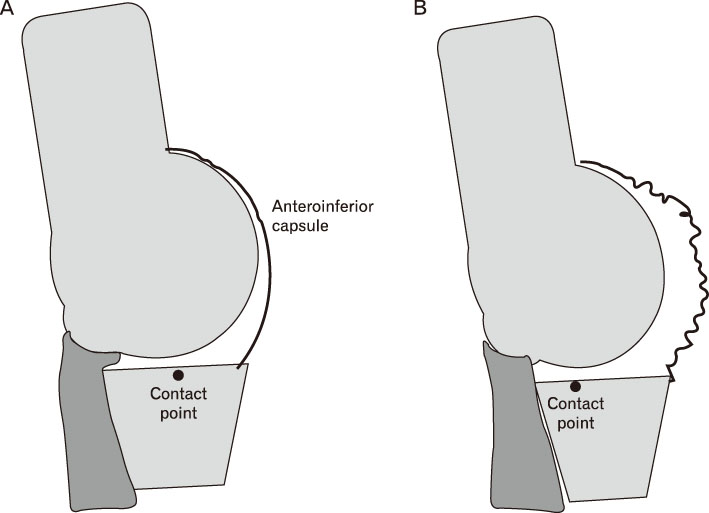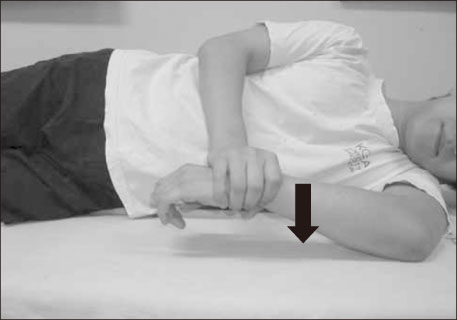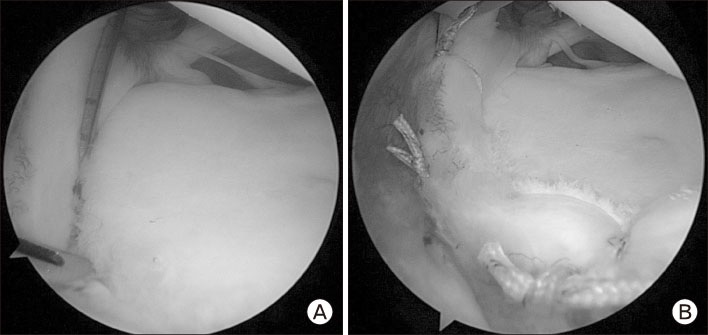Korean J Sports Med.
2018 Dec;36(4):173-179. 10.5763/kjsm.2018.36.4.173.
Microinstability of the Shoulder
- Affiliations
-
- 1Department of Orthopedic Surgery, Korea University Guro Hospital, Seoul, Korea. moonjg@korea.ac.kr
- KMID: 2428000
- DOI: http://doi.org/10.5763/kjsm.2018.36.4.173
Abstract
- A variety of theories have been reported as causes of shoulder pain in overhead throwing athletes. Recently, an explanation with microinstability of the shoulder and internal impingement has been proposed. The concept of the microinstability is that pathologic laxity of the anterior capsule caused by repeated abduction and external rotation of the shoulder leads to abnormal glenohumeral biomechanics and causes internal impingement of the shoulder. Based on the understanding of the pathology, it is recommended to identify the causes of shoulder pain in the overhead throwing athletes and perform appropriate rehabilitation or surgical treatment.
Keyword
Figure
Reference
-
1. Rowe CR. Recurrent transient anterior subluxation of the shoulder: the “dead arm” syndrome. Clin Orthop Relat Res. 1987; (223):11–19.2. Bennett GE. Baseball and other athletic injuries. Med Times. 1959; 87:302–304.3. Tibone JE, Jobe FW, Kerlan RK, et al. Shoulder impingement syndrome in athletes treated by an anterior acromioplasty. Clin Orthop Relat Res. 1985; (198):134–140.
Article4. Perry J. Anatomy and biomechanics of the shoulder in throwing, swimming, gymnastics, and tennis. Clin Sports Med. 1983; 2:247–270.
Article5. Tibone JE, Elrod B, Jobe FW, et al. Surgical treatment of tears of the rotator cuff in athletes. J Bone Joint Surg Am. 1986; 68:887–891.
Article6. Andrews JR, Carson WG Jr, McLeod WD. Glenoid labrum tears related to the long head of the biceps. Am J Sports Med. 1985; 13:337–341.
Article7. Garth WP Jr, Allman FL Jr, Armstrong WS. Occult anterior subluxations of the shoulder in noncontact sports. Am J Sports Med. 1987; 15:579–585.
Article8. Walch G, Boileau P, Noel E, Donell ST. Impingement of the deep surface of the supraspinatus tendon on the posterosuperior glenoid rim: an arthroscopic study. J Shoulder Elbow Surg. 1992; 1:238–245.
Article9. Burkhart SS, Morgan C. SLAP lesions in the overhead athlete. Orthop Clin North Am. 2001; 32:431–441.
Article10. Castagna A, Nordenson U, Garofalo R, Karlsson J. Minor shoulder instability. Arthroscopy. 2007; 23:211–215.
Article11. Chambers L, Altchek DW. Microinstability and internal impingement in overhead athletes. Clin Sports Med. 2013; 32:697–707.
Article12. Burkhart SS, Morgan CD, Kibler WB. The disabled throwing shoulder: spectrum of pathology part I: pathoanatomy and biomechanics. Arthroscopy. 2003; 19:404–420.
Article13. Bigliani LU, Codd TP, Connor PM, Levine WN, Littlefield MA, Hershon SJ. Shoulder motion and laxity in the professional baseball player. Am J Sports Med. 1997; 25:609–613.
Article14. Jobe FW, Kvitne RS, Giangarra CE. Shoulder pain in the overhand or throwing athlete: the relationship of anterior instability and rotator cuff impingement. Orthop Rev. 1989; 18:963–975.15. Grossman MG, Tibone JE, McGarry MH, Schneider DJ, Veneziani S, Lee TQ. A cadaveric model of the throwing shoulder: a possible etiology of superior labrum anterior-to-posterior lesions. J Bone Joint Surg Am. 2005; 87:824–831.16. Burkhart SS, Lo IK. The cam effect of the proximal humerus: its role in the production of relative capsular redundancy of the shoulder. Arthroscopy. 2007; 23:241–246.
Article17. Jobe FW, Giangarra CE, Kvitne RS, Glousman RE. Anterior capsulolabral reconstruction of the shoulder in athletes in overhand sports. Am J Sports Med. 1991; 19:428–434.
Article18. Halbrecht JL, Tirman P, Atkin D. Internal impingement of the shoulder: comparison of findings between the throwing and nonthrowing shoulders of college baseball players. Arthroscopy. 1999; 15:253–258.
Article19. Burkhart SS, Morgan CD, Kibler WB. The disabled throwing shoulder: spectrum of pathology part III: the SICK scapula, scapular dyskinesis, the kinetic chain, and rehabilitation. Arthroscopy. 2003; 19:641–661.
Article20. Burn MB, McCulloch PC, Lintner DM, Liberman SR, Harris JD. Prevalence of scapular dyskinesis in overhead and nonoverhead athletes: a systematic review. Orthop J Sports Med. 2016; 4:2325967115627608.21. Kibler WB, Thomas SJ. Pathomechanics of the throwing shoulder. Sports Med Arthrosc Rev. 2012; 20:22–29.
Article22. Spiegl UJ, Warth RJ, Millett PJ. Symptomatic internal impingement of the shoulder in overhead athletes. Sports Med Arthrosc Rev. 2014; 22:120–129.
Article23. Cools AM, Cambier D, Witvrouw EE. Screening the athlete's shoulder for impingement symptoms: a clinical reasoning algorithm for early detection of shoulder pathology. Br J Sports Med. 2008; 42:628–635.
Article24. Davidson PA, Elattrache NS, Jobe CM, Jobe FW. Rotator cuff and posterior-superior glenoid labrum injury associated with increased glenohumeral motion: a new site of impingement. J Shoulder Elbow Surg. 1995; 4:384–390.
Article25. Burkhart SS, Morgan CD, Kibler WB. The disabled throwing shoulder: spectrum of pathology. Part II: evaluation and treatment of SLAP lesions in throwers. Arthroscopy. 2003; 19:531–539.
Article26. McFarland EG, Tanaka MJ, Papp DF. Examination of the shoulder in the overhead and throwing athlete. Clin Sports Med. 2008; 27:553–578.
Article27. Reinold MM, Curtis AS. Microinstability of the shoulder in the overhead athlete. Int J Sports Phys Ther. 2013; 8:601–616.28. Kibler WB, Sciascia A, Thomas SJ. Glenohumeral internal rotation deficit: pathogenesis and response to acute throwing. Sports Med Arthrosc Rev. 2012; 20:34–38.29. Meister K, Buckley B, Batts J. The posterior impingement sign: diagnosis of rotator cuff and posterior labral tears secondary to internal impingement in overhand athletes. Am J Orthop (Belle Mead NJ). 2004; 33:412–415.30. Chang EY, Fliszar E, Chung CB. Superior labrum anterior and posterior lesions and microinstability. Magn Reson Imaging Clin N Am. 2012; 20:277–294.
Article31. Mistry A, Campbell RS. Microinstability and internal impingement of the shoulder. Semin Musculoskelet Radiol. 2015; 19:277–283.
Article32. Davies GJ, Dickoff-Hoffman S. Neuromuscular testing and rehabilitation of the shoulder complex. J Orthop Sports Phys Ther. 1993; 18:449–458.
Article33. Lintner D, Mayol M, Uzodinma O, Jones R, Labossiere D. Glenohumeral internal rotation deficits in professional pitchers enrolled in an internal rotation stretching program. Am J Sports Med. 2007; 35:617–621.
Article34. Sayde WM, Cohen SB, Ciccotti MG, Dodson CC. Return to play after type II superior labral anterior-posterior lesion repairs in athletes: a systematic review. Clin Orthop Relat Res. 2012; 470:1595–1600.
Article35. Reynolds SB, Dugas JR, Cain EL, McMichael CS, Andrews JR. Debridement of small partial-thickness rotator cuff tears in elite overhead throwers. Clin Orthop Relat Res. 2008; 466:614–621.36. Shaffer B, Huttman D. Rotator cuff tears in the throwing athlete. Sports Med Arthrosc Rev. 2014; 22:101–109.
Article37. Liem D, Lichtenberg S, Magosch P, Habermeyer P. Arthroscopic rotator cuff repair in overhead-throwing athletes. Am J Sports Med. 2008; 36:1317–1322.
Article38. Sonnery-Cottet B, Edwards TB, Noel E, Walch G. Results of arthroscopic treatment of posterosuperior glenoid impingement in tennis players. Am J Sports Med. 2002; 30:227–232.
Article39. Montgomery WH 3rd, Jobe FW. Functional outcomes in athletes after modified anterior capsulolabral reconstruction. Am J Sports Med. 1994; 22:352–358.
Article40. Levitz CL, Dugas J, Andrews JR. The use of arthroscopic thermal capsulorrhaphy to treat internal impingement in baseball players. Arthroscopy. 2001; 17:573–577.
Article41. D'Alessandro DF, Bradley JP, Fleischli JE, Connor PM. Prospective evaluation of thermal capsulorrhaphy for shoulder instability: indications and results, two- to five-year follow-up. Am J Sports Med. 2004; 32:21–33.42. Fedoriw WW, Ramkumar P, McCulloch PC, Lintner DM. Return to play after treatment of superior labral tears in professional baseball players. Am J Sports Med. 2014; 42:1155–1160.
Article43. Boileau P, Parratte S, Chuinard C, Roussanne Y, Shia D, Bicknell R. Arthroscopic treatment of isolated type II SLAP lesions: biceps tenodesis as an alternative to reinsertion. Am J Sports Med. 2009; 37:929–936.44. Wilk KE, Macrina LC. Nonoperative and postoperative rehabilitation for injuries of the throwing shoulder. Sports Med Arthrosc Rev. 2014; 22:137–150.
Article





